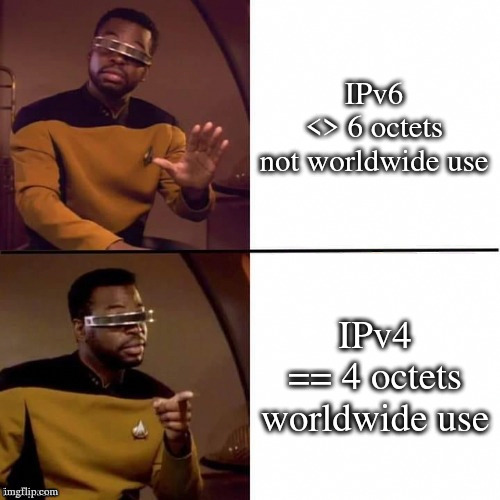this post was submitted on 19 Jun 2024
314 points (85.7% liked)
Programmer Humor
19555 readers
1197 users here now
Welcome to Programmer Humor!
This is a place where you can post jokes, memes, humor, etc. related to programming!
For sharing awful code theres also Programming Horror.
Rules
- Keep content in english
- No advertisements
- Posts must be related to programming or programmer topics
founded 1 year ago
MODERATORS
you are viewing a single comment's thread
view the rest of the comments
view the rest of the comments

Because 48 bits over 32 bits does not really solve the problems with ip4. 128 bits basically gives one ip4 address space to each square meter of earth. Ip6 also drops all the unused and silly parts of ip4 too.
That sounds like terminal stage capitalism to me. Why would we want every tree in the Amazons to be cybergorized with its own IP? I don't know Rick, 64 ~~kbits~~ bits ought to be enough for everybody, and I'm already risking it.
Our network architecture has the tendency to waste IP addresses. A subnet may have 10 devices but have 256 IPs (e.g. a /24 network like 192.168.0.0 to 192.168.0.255) - that's 246 wasted addresses. This wastage is kinda unavoidable since we'd need to keep our routing tables from being too fragmented.
With that in mind it is entirely possible for 64-bit addressing space to not be enough, unless we revert to methods like NAT which come with their own disadvantages.
We have already used up about one /11 block of the IPv6 internet. That's 128-11=117 bits. If we replace the standardized /64 subnets of IPv6 with old /24 subnets typical in IPv4 networks, you get 61 bits. That's dangerously close to the upper limit of a hypothetical 64-bit IPv5 internet.
Because bits are not expensive anymore, and if we used 64 bits, we might run out faster than the time needed to convert to a new standard. (After all, IPv4 is still around 26 years after IPv6 was drafted.) Also see the other notes about how networks get segmented in non-optimal ways. It's a good thing to not have to worry about address space when designing your network.